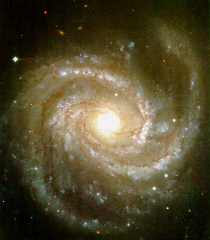 | |||
|
| Home > Public Information > Dissemination of Astronomy > Blue Super Giants |
The Biggest and Brightest Stars in the Universe
All of the stars that you see in the sky are members of our Galaxy, called the Milky Way. The Sun is an ordinary, typical star, and if you could stand on the surface of one of these stars, the sun would appear as just another speck of light in the darkness. Stars are, in effect, enormous balls of gas with central nuclear reactors converting mass to energy in a scalding inferno of temperatures in excess of 10 million°C at their cores. By the time the energy has bubbled up to the surface of the Sun through a dense, turbulent atmosphere, it has cooled to a mere 5000°C. Most stars are very similar in size, mass and temperature to our own Sun, but there are a few rare exceptions which make our Sun look tiny. The most massive stars in the Galaxy are up to 100 times more massive than the Sun (the Sun is 300 million times more massive than earth). Their centres are much denser and hotter and they burn their nuclear fuel much more quickly. They are amazingly luminous and shine as brightly as a million suns. These stars have surface temperatures of between 20,000 - 50,000°C and appear blue in colour. They are termed 'blue supergiants' due to their appearance and the enormous amounts of energy that they can radiate. They are rare - if you take a bunch of stars at random in our Galaxy, less than 0.1% of them will be blue supergiant stars. Their lifetimes are a mere 10 million years (the Sun's is about 10 billion) - by the time the Sun has lived and died, a thousand blue supergiants could have been born, lived their fiery existence and exploded into oblivion. So how do we find these rare, enigmatic blue stars for our telescopes to study them in detail ? Thankfully, because they are so bright, they stand out as bright blue objects in the sky - an example you can see is the Rigel star in the Orion constellation which has a mass of around twenty times that of the Sun and gives out more light than 60,000 suns added together. Even during the short lifetimes of these blue supergiants, things are not as stable as they may appear. So much energy is created in the centres of these stars that they are always on the edge of catastrophe. The energy has to escape somehow, and as it radiates from the core to the surface, it blows off the outer layers of the star at velocities of up to 1700 kilometres per second (six million kilometres per hour!). This outflow is called a stellar wind, and is currently the topic of intensive study using the telescopes on La Palma, the Hubble Space Telescope and others throughout the world. As we will see later in the article, these winds are gifts of nature for astronomers as tools for uncovering the great questions of the Universe. Eventually there can be only one outcome, when the nuclear fuel in the star's core is exhausted, no energy is available to support the outer layers which collapse under gravity. There is a huge explosion and the star blows itself apart in an event called a supernova. By comparison, the Sun's lifetime will be relatively mundane and no fantastic explosion is predicted before it fades away in the cosmic wilderness. A famous stellar astronomer (Martin Schwarzschild) has likened the Sun to a poor man who has little and spends thriftily while a supergiant is like a rich man who has much and spends prodigiously. Very soon the rich man discovers he has no more money in reserve. However, unlike the poor man who finds himself in the same predicament and fades into obscurity, the rich man blows himself apart! The fantastic brightness of the huge blue supergiants means that we can use the powerful telescopes of the ING to observe these stars in other galaxies, not just our own. Galaxies are normally studied by looking at their total light, which is made up of light from all the 10 billion or so stars which are members of the galaxy. But we can now look at individual blue supergiants in very far off systems - remember that a single blue supergiant can be brighter than a million suns all put together. A very distant galaxy which has a large amount of visible blue supergiants is M100 (see picture). This Galaxy is approximately 25 million light years away, and is a member of the cluster of galaxies that lie in the constellation of Virgo. The Universe appears to be expanding, and all the distant galaxies are rushing away from each other. We can estimate the age of the Universe by calculating when these galaxies were close together, and hence how long ago the early Universe formed. To do this we need to know two things about a galaxy - its distance from us, and the speed at which it is moving away from our Galaxy. The speed can easily be calculated from a spectrum of the whole galaxy, whereas distance measurements have been a source of controversy for many years.
The winds of the blue supergiants are indeed a gift from nature - by taking spectra of individual stars in a far off galaxy (such as M100), we can estimate the velocity of their winds. The speed at which the wind is blown off the star is proportional to the size of the star and hence its intrinsic brightness. On a dark night you can tell how far away a car is on the road by looking at how bright its headlights are - you know how bright they really are close up, so you automatically calculate the distance to the car. We do the same with these blue supergiants - from their winds we know how bright they would be if they were nearby, and we can see how bright they really are in our telescopes. So we can calculate a distance to the galaxy that they are in, and hence determine the age of the Universe.
|
| Top | Back |
|



